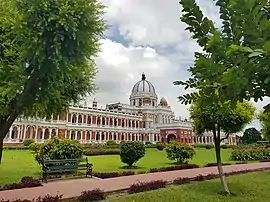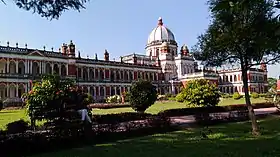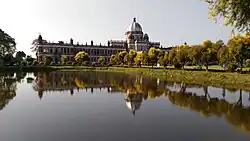Cooch Behar Palace
Cooch Behar Palace, is a landmark in Cooch Behar city, West Bengal. It was designed after the Italian Renaissance style of architecture and was built in 1887, during the reign of Maharaja Nripendra Narayan of Koch dynasty. It is currently a museum.[1]
| Cooch Behar Palace | |
|---|---|
 Façade of the Cooch Behar Palace | |
| General information | |
| Architectural style | Classical Western / Italian Renaissance |
| Location | Cooch Behar, West Bengal, India |
| Coordinates | 26°19′37.28″N 89°26′11.23″E |
| Construction started | 1887 |
| Client | Maharaja Nripendra Narayan |
History
| Part of a series on |
| Zamindars of Bengal |
|---|
 |
The Cooch Behar Palace is noted for its elegance and grandeur. It is a brick-built double-story structure in the Classical Italian style covering an area of 51,309 square feet (4,766.8 m2). The whole structure is 395 feet (120 m) long and 296 feet (90 m) wide and is on rests 4 feet 9 inches (1.45 m) above the ground. The Palace is fronted on the ground and first floors by a series of arcaded verandahs with their piers arranged alternately in single and double rows. At the southern and northern ends, the Palace projects slightly and in the center is a projected porch providing an entrance to the Durbar Hall. The Hall has an elegantly shaped metal dome which is topped by a cylindrical louver type ventilator. This is 124 feet (38 m) high from the ground and is in the style of the Renaissance architecture. The intros of the dome is carved in stepped patterns and Corinthian columns support the base of the cupola. This adds variegated colors and designs to the entire surface. There are various halls in the palace and rooms that include the grand Durbar Hall or the hall of audience, Drawing Rooms, Dining Hall, Billiard Room, Library, Bed Rooms, Toshakhana, Ladies Gallery and Vestibules. The articles and precious objects that these rooms and halls used to contain are now lost. The original palace was partially a 3 storeyed structure, but was subsequently destroyed by the 1897 Assam earthquake. The palace shows the acceptance of European idealism of the Koch kings.[2] According to the List of Monuments of National Importance in West Bengal the Cooch Behar Palace is an ASI listed monument.[3]

Architecture
The Rajbari or the Cooch Behar Palace is a grand monument constructed in the Italian Renaissance form of architecture.[5] The entire monument expands gracefully over an area of 51,000 square feet; about 390 feet long and 296 feet wide and is a brick-built structure. The monument stands 125 feet tall from the ground and has the entrance on the ground floor with a projected porch that leads to the Durbar Hall. The first floor has a series of beautiful arcaded verandas with alternately arranged piers in double and single rows. The palace houses over 50 rooms including bedrooms, dressing rooms, billiard room, kitchen, dining hall, dancing hall, library, Tosha khana and the ladies gallery.[5][6]
Durbar Hall
A splendid porch positioned in the center of the monument serves as an entrance to Rajbari through the Durbar Hall.[7] The Durbar Hall has a beautiful metal dome with a cylindrical louvre on the top that also acts as a ventilator. The dome is at 124 feet high from the ground level and is built in the traditional Italian Renaissance architecture. The dome also is beautifully carved in step pattern and rests on four arches supported by huge Corinthian columns adorned with a lantern on the top. Several small yet elegant balconies also surround the dome of the Durbar Hall.[5][8]
Best Time To Visit
The best time to visit Rajbari is between November and February as the weather is pleasant during the season with the maximum temperature ranging from 23 to 27 degrees Celsius and minimum ranging from 9 to 13 degrees Celsius. April to June are the summer months with temperatures ranging from a maximum of 33 degrees Celsius and minimum of 20 degrees Celsius whereas the Monsoon months, July to October, receive an average annual rainfall of about 3200 mm.[5][9]
Tips For Visiting
- No food items are allowed inside the palace premises.
- Provisions have been made for clean drinking water for visitors.
- Toilet facilities are available.
- Photography is not allowed inside the main building.[9]
Gallery
References
- Cooch Behar Rajbari Museum coochbehar.nic.in. Retrieved 2 October 2021
- "Official Website of Cooch Behar district in West Bengal". Coochbehar.nic.in. Retrieved 25 October 2016.
- "List of Ancient Monuments and Archaeological Sites and Remains of West Bengal - Archaeological Survey of India". Item no. 57. ASI. Retrieved 7 August 2020.
- "Rajbari in Cooch Behar town".
- "About Rajbari". holidify. 9 July 2023. Retrieved 7 July 2023.
- "Famous Cooch Behar Palace". unacademy.com. Retrieved 9 July 2023.
- "Cooch Behar Galery". Cooch Behar District. 9 July 2023.
- "Cooch Behar Palace in West Bengal: Elegance spanning 51,309 sq ft". housing.com. 24 February 2021. Retrieved 9 July 2023.
- "Cooch Behar Palace: An Architectural Masterpiece". squareyards. 25 May 2023. Retrieved 9 July 2023.



